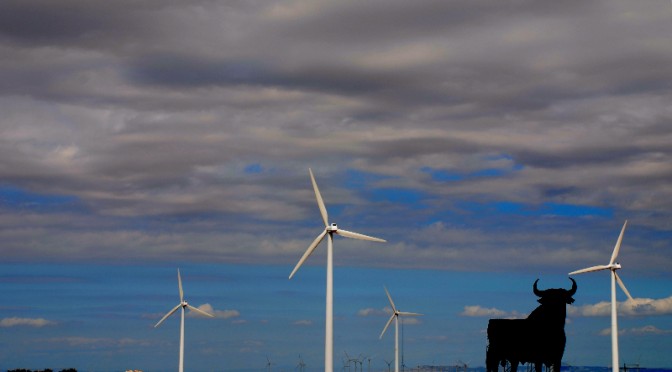Wind energy becomes the first installed power technology in the peninsula, ahead of the combined cycle that until now had been the leader.
The year 2019 has marked a turning point in the transition of the peninsular electricity system towards a sustainable energy model. The integration of 6,528 MW of new renewable generation has meant that for the first time ‘green’ energy exceeds (52%) the rest of the technologies in the peninsular generating park, which closed the year with a record figure of 104.8 GW. Furthermore, this increase has managed to position wind power as the leader in installed capacity on the peninsula – ahead even of the combined cycle – with a total generation capacity of 25,255 MW.
At the end of 2019, the renewable quota on the peninsula amounted to a total of 54,457 MW, of which 46% are wind power, 16% are photovoltaic and the rest (38%) correspond to other renewable technologies like concentrated solar power. This is reflected in the Preview of the Spanish Electric System Report 2019 of Red Eléctrica de España, which was published today. In the words of the president of Red Eléctrica, Beatriz Corredor, “these data reflect our progress towards the energy transition and compliance with the integration of renewables established in the National Integrated Energy and Climate Plan. For Corridor, “it is essential to continue advancing on the path of decarbonisation of the economy because it is our responsibility, not only as a company, but as conscious and responsible citizens.”
In 2019, the electricity generation park on the peninsula experienced an increase of 6.2% compared to 2018, mainly thanks to the 13.6% growth in renewable installed capacity. This remarkable fact has been materialized in the commissioning of a total of 6,528 MW of renewable generation. Photovoltaic solar, which closed the year with 8,623 MW of installed power, was the technology that most increased its presence in 2019, with an increase of 93.2% (4,159 MW) compared to the previous year.
From a regional point of view, the new renewable generation capacity has been concentrated for the most part in seven autonomous communities (by order, Aragón, Andalucía, Castilla- La Mancha, Castilla y León, Extremadura, Murcia and Galicia). Each of them has put into service more than 400 ‘green’ MW in 2019.
A greener and decarbonized generation mix
The increase in renewable installed capacity has allowed that of the 247,002 GWh of electricity generated in the peninsula in 2019, 39% has been produced from these technologies. Wind power, with a 21.5 contribution, was second in the mix, after nuclear power (22.6%) and followed by the combined cycle (20.7%).
This past year the energy mix has shown that Spain is strongly committed to renewables, but it is also making progress in the decarbonisation process. 2019 recorded the lowest participation of this technology since Red Eléctrica has registration. It only represented 4.3% of the total generation compared to 14.1% in 2018. In addition, the year ended with an unprecedented event in the history of the peninsular electricity system: the so-called ‘zero’ in coal or, what It is the same, a whole day without generating a single MWh with this fossil fuel. It happened on December 14 and was repeated four more days during that month (December 21, 22, 24 and 25).
One of the main consequences of this boost to decarbonisation has been the decrease in CO2 emissions associated with electricity generation, which have marked an all-time low since records were recorded (1990): 40.6 million tons of CO2, 25.5% less than in 2018.
On the other hand, the demand for electrical energy in the peninsula during this year was 249,144 GWh, slightly lower than in 2018 (1.7% less). If the effects of labor and temperatures are taken into account, its decrease is 2.7% compared to the previous year.
The national electrical system, increasingly “green”
At the national level, unequivocal progress is also being made on the path of energy transition. In 2019, the increase in renewable installed capacity has meant that for the first time these technologies already reach 50% of the country’s total generation capacity (110 GW in total). In its entirety, the Spanish generating park has grown by 5.9%. The combined cycle continues to be the leader in installed power (23.8% of the total) but it is closely followed by two renewable sources: wind (23.3%) and hydro (15.5%).
Specifically, this past year 6,539 ‘green’ MW entered service, which has meant an increase in renewable generation capacity of 13.4% compared to 2018. The renewable contingent closed 2019 with a figure of 55,195 MW, of 47% of which are wind, 16% photovoltaic and 37% belong to other ‘green’ technologies.


